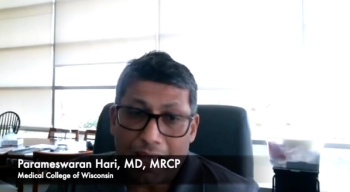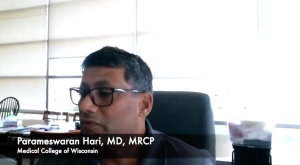
Concluding their discussion on newly diagnosed multiple myeloma, expert panelists consider treatment options for patients with high-risk disease.

Your AI-Trained Oncology Knowledge Connection!


Concluding their discussion on newly diagnosed multiple myeloma, expert panelists consider treatment options for patients with high-risk disease.

Shared insight on the evolving treatment landscape of transplant-ineligible newly diagnosed multiple myeloma.

After reviewing the case of a patient with transplant-eligible newly-diagnosed multiple myeloma, experts consider optimal selection of first-line treatment.

Parameswaran Hari, MD, MRCP, discussed second malignancies and second transplants for patients who stopped versus continued lenalidomide maintenance therapy to treat multiple myeloma from a follow-up trial presented at the 2020 ASCO Virtual Scientific Program.

Parameswaran Hari, MD, MRCP, discussed the progression-free survival of patients who stopped versus continued lenalidomide maintenance therapy to treat multiple myeloma from a follow-up trial presented at the 2020 ASCO Virtual Scientific Program.

Multiple myeloma is now the most common indication for autologous stem cell transplantation (ASCT) in North America, with over 5,000 transplants performed yearly (Center for International Blood and Marrow Transplant Research [CIBMTR] data). While the role of ASCT as initial therapy in multiple myeloma has been established by randomized studies, newer therapies are challenging the traditional paradigm. The availability of novel induction agents and newer risk stratification tools, and the increasing recognition of durability of remissions are changing the treatment paradigm. However, even with arduous therapy designed to produce more complete remissions—for example, tandem autologous transplants—we have seen no plateau in survival curves. A tandem autologous procedure followed by maintenance therapy may be performed in an attempt to sustain remission. Sequential autologous transplants followed by nonmyeloablative allotransplants are pursued with the hope of "curing" multiple myeloma. We examine how the key challenges of increasing the response rates and maintaining responses are being addressed using more effective induction and/or consolidation treatments and the need for maintenance therapies after ASCT. We argue that given the biologic heterogeneity of multiple myeloma, risk-adapted transplant approaches are warranted. While the role of curative-intent, dose-intense toxic therapy is still controversial, conventional myeloablative allogeneic transplants need to be reexamined as an option in high-risk aggressive myeloma, given improvements in supportive care and transplant-related mortality.

Bolaños-Meade et al provide aconcise review of tandemtransplantation for patientswith multiple myeloma. High-dosechemotherapy with autologous stemcell support has been shown to improveresponse rates, event-free survival,and overall survival overconventional chemotherapy in a majorrandomized clinical trial-the IntergroupeFrançais du Myélome(IFM)-90 trial.[1] This procedure isnow accepted as the standard of carefor newly diagnosed myeloma patientsyounger than age 70 years. However,the same study demonstrated the needto improve upon single autografts, asthe overall survival rate at 7 years inthe transplant group was only 43%.Conceptual Basis ofTandem AutograftsUsing tandem transplants, investigatorshave aimed to improve outcomesby incrementally achievinghigher complete response rates withrepeated cycles of high-dose therapyrequiring stem cell support. With theirTotal Therapy protocol-a series ofnon–cross-resistant chemotherapyregimens culminating in tandemtransplantation-researchers from theArkansas Cancer Research Centershowed that the complete responserate increased from 26% to 41%following the first and second transplant,respectively.[2] On multivariateanalysis, complete response wasa significant prognostic factor forimproved outcome.

Published: July 18th 2020 | Updated:

Published: March 1st 2003 | Updated:

Published: September 1st 2006 | Updated:

Published: June 5th 2020 | Updated: